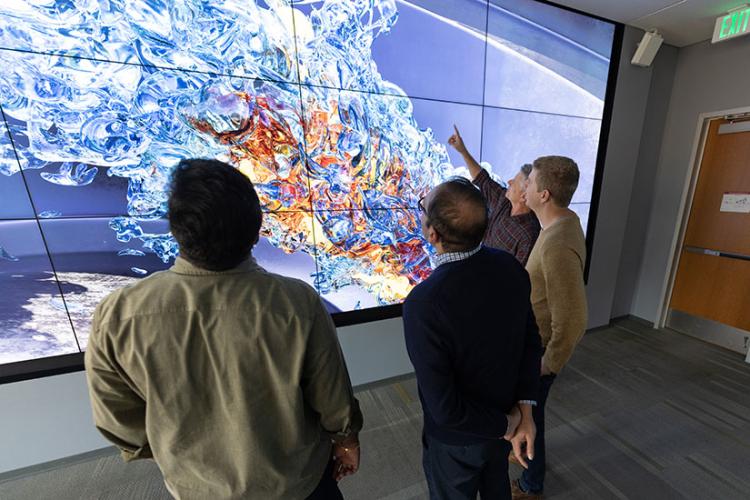By Erik F. Ringle
Laboratory Supports Industry in Fine-Tuning Sustainable Aviation Fuel Chemistry Ahead of Seeking Approval for Widespread Airplane Use

Researchers from NREL's Computational Science Center look at a detailed simulation of sustainable aviation fuel as it combusts in a "virtual jet engine." Photo by Joe DelNero, NREL
Gasoline became unleaded in the 1970s. The sulfur content of diesel has been lowered over decades. Ethanol has been blended into gasoline for years. The historical timeline of liquid transportation fuels is colored by change after change to fuel chemistry.
However, that cannot be said of petroleum jet fuel. Its properties have changed little since it first became widely used beginning in the 1950s, buoyed by a long record of safety, performance, and ease-of-use.
But changes are coming for jet fuel, and the aviation industry is actively inviting them. Public and private investments are growing to accelerate the production and use of sustainable aviation fuel (SAF), an energy-dense, renewable fuel seen as essential for decarbonizing flight.
Like changes to gasoline and diesel chemistry in the past, adopting SAF means proving the fuel is as safe and reliable as the old stuff as well as being fully compatible with existing jet engines. For an industry that has built its fleet around a fuel unchanged for 70 years, that could mean a steep learning curve.
"This idea of designing a new jet fuel is like a completely new concept to the aviation industry," said Robert McCormick, a senior research fellow at the U.S. Department of Energy's (DOE's) National Renewable Energy Laboratory (NREL). "Essentially, they've designed the engines around this one fuel: Jet A, which has been the standard petroleum jet fuel for years."
Fortunately, the aviation industry does not have to find a replacement for Jet A alone. In a project supported by the DOE, a cross-disciplinary research team is gathering meticulous fuel chemistry data to equip the industry with an ultra-detailed SAF combustion simulation. Powered by supercomputers, the "virtual jet engine" can predict how SAF performs during flight and provide insights on how to tune it to maximize its safety and performance. The simulations will be validated with data captured in combustion test cells at General Electric and Georgia Institute of Technology.
If successful, the SAF research platform, built using a suite of custom modeling tools called Pele in collaboration with NREL's Computational Science Center, may help industry avoid costly surprises when seeking approval for new SAFs from ASTM International. More fundamentally, it might reveal frontiers never seen before in jet fuel chemistry insights that could help planes fly further, run cleaner, and perform better than ever before.
Click here to read the full story...
Media may contact:
David Glickson
303-275-4097
david.glickson@nrel.gov
Learn more about NREL's security and privacy policies.
NREL is a national laboratory of the U.S. Department of Energy, Office of Energy Efficiency and Renewable Energy, operated by the Alliance for Sustainable Energy, LLC.









